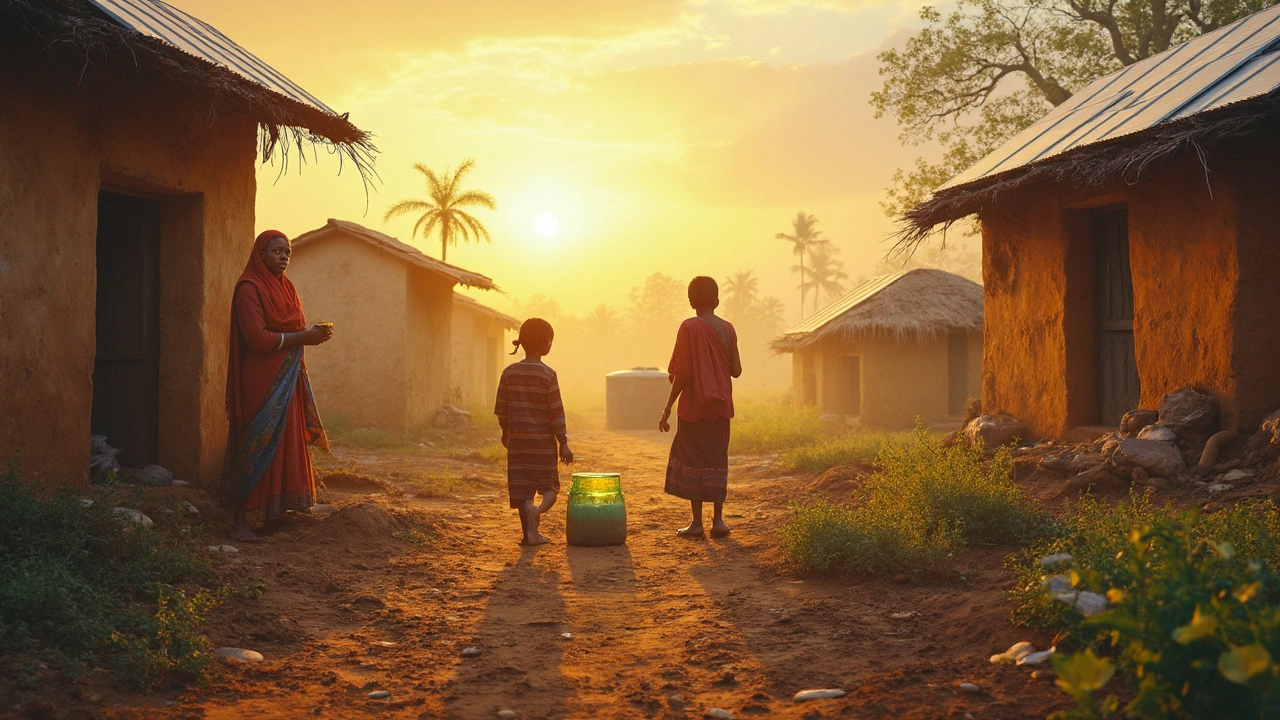Will the Earth Be Uninhabitable by 2070? A Realistic Look at the Next 45 Years
 Apr, 29 2025
Apr, 29 2025
When people say the Earth might be uninhabitable by 2070, it sounds like the plot of a sci-fi movie. But here’s the thing—some scientists aren’t joking. They’re warning that if the world keeps heating up, there could be places where stepping outside feels like sitting in a car with the windows up in the sun, all day, every day.
Some climate models predict global temperatures could jump by 2°C to 4°C (that’s 3.6°F to 7.2°F) this century. That might not sound insane, but even a couple degrees mess with food growth, water supplies, and where disease-carrying mosquitoes can live. Weird weather, heatwaves, and floods—all more likely when the planet is running a fever.
The big question isn’t just how hot it’ll get. It’s who gets hit first, and what we can do before it’s too late. Lucky for us, there’s a lot we can actually change, both as regular people and as countries making big choices. But doing nothing? Not really an option if you like stable weather and breathing easily.
- How Hot Could It Get by 2070?
- What Makes a Place Unlivable?
- Which Parts of the World Are Most at Risk?
- Can Tech and Policy Save Us?
- How You Can Prepare and Make a Difference
How Hot Could It Get by 2070?
So, how much are we actually talking about when it comes to rising temps by 2070? It’s not just a few sweaty days in July. According to the most recent climate change reports, if we keep burning fossil fuels like we are, we’re looking at average global temperatures rising between 2°C and 4°C (about 3.6°F to 7.2°F) by 2070. That seems small, but the last time Earth was even 2°C warmer, sea levels were six meters higher and forests grew all the way to the North Pole.
Here’s the wild part: It’s not an even jump everywhere. Some spots—like parts of India, Africa, and the Middle East—could face global warming so extreme that stepping outdoors in summer could be dangerous. In heatwaves, ‘feels like’ temps might top 50°C (122°F), which is basically unlivable for humans long term.
| Scenario | Predicted Temp Increase by 2070 |
|---|---|
| Low emissions (best case) | ~1.5°C (2.7°F) |
| Current path (business as usual) | 2-4°C (3.6-7.2°F) |
| High emissions (worst case) | 5°C+ (9°F+) |
Scientists aren’t just pulling these numbers out of thin air. The Intergovernmental Panel on Climate Change (IPCC) has warned that we’re already at 1.2°C above the pre-industrial average as of April 2025, and the pace is picking up from things like car exhaust, air travel, and power plants.
What does this feel like on the ground? Heatwaves that last weeks instead of days, nighttime temperatures that never cool off, and way more wild weather everywhere. Crops don’t grow well in constant heat, and people’s health takes a hit when the body can’t cool down, especially in cities packed with concrete.
If you’re thinking, “Maybe technology will save us,” that stuff helps, but unless we slow down emissions and ramp up clean energy, the planet’s going to keep heating up. The message is simple: these rising temps are a big deal now, not just for the future. That’s why staying informed and acting on it really matters.
What Makes a Place Unlivable?
Not everywhere on Earth turns into a wasteland overnight, but certain conditions can push a place over the edge. It’s not just about extreme global warming—it’s about what that heat does to air, water, food, and your basic ability to survive outside.
First up, heat and humidity can team up to become truly dangerous. Scientists point to something called the “wet-bulb temperature.” That’s when it’s so hot and muggy, sweat basically stops working to cool you off. A wet-bulb temperature of 35°C (95°F) is considered the upper limit of what the human body can handle for more than a few hours. If this happens, even fit young people can die just by being outside—shade and fans won’t help much.
Clean water is another dealbreaker. As climate change ramps up, droughts last longer and hit harder. You end up with less water to drink, irrigate crops, or keep power plants running. That can make modern life straight-up impossible in some places.
Don’t forget about food. Crops like wheat, corn, and rice really hate extreme heat. The longer heatwaves last, the more the risk of massive crop failures. Add in pests and diseases that spread with warmer weather, and some regions could see major food shortages.
Certain air quality levels make areas unsafe too. More wildfires mean smoky skies that are hazardous to breathe. Cities with aging infrastructure get overwhelmed when storms get stronger and flooding becomes common, making some neighborhoods basically unlivable for months out of the year.
- Heat & Humidity: Wet-bulb temps above 35°C make survival outdoors impossible.
- Water Shortage: Droughts dry up lakes, rivers, and reservoirs.
- Food Scarcity: Crop failures pile up, food prices spike, malnutrition rises.
- Bad Air: Wildfire smoke and pollution make it hard to breathe or go outside.
- Unstable Infrastructure: Constant flooding or heat damages roads, homes, and power lines.
| Risk Factor | Threshold | Impact |
|---|---|---|
| Wet-bulb Temp | 35°C (95°F) | Deadly heat stress |
| Annual Rainfall | < 250 mm | Long-term drought |
| Crop Loss | > 40% | Food shortage |
| Air Quality Index | > 300 | Health warnings |
Sometimes, regular blackouts or constant flooding are enough to make people pack up and move. When these stressors team up, a place that was once home can quickly turn into a spot people leave in droves—sometimes with no option to return. That’s what climate change is really threatening over the next decades.

Which Parts of the World Are Most at Risk?
If you’ve read any headlines about climate change and the planet getting hotter, you’ve probably seen maps filled with angry reds and oranges. But who really needs to worry? Let’s get specific: huge regions near the equator, packed with millions of people, are on the front lines. Cities in South Asia, West Africa, the Middle East, and parts of Central and South America are staring down serious trouble if things don’t change.
By 2070, places like India, Pakistan, Nigeria, and the Persian Gulf could have heatwaves that physically stop people from working outside safely for days or weeks at a stretch. In 2023, Jacobabad, Pakistan, hit 52°C (125.6°F), and events like this might turn normal. Imagine your city’s hottest summer ever, but every year—without enough reliable AC or water.
Low-lying areas don’t get a free pass either. With rising sea levels, big chunks of coastal Bangladesh, Vietnam, and even parts of Florida risk regular flooding or just being erased from maps. Island nations like the Maldives or Tuvalu could lose most of their land, displacing entire countries.
Here’s a quick look at some of the highest-risk spots and why:
- South Asia: Heatwaves, water shortages, and crop failures threaten India, Pakistan, and Bangladesh.
- Sub-Saharan Africa: Long droughts plus intense heat means trouble for farming and access to drinking water.
- Middle East: Already super hot, but expect harsher heat and less water availability.
- Southeast Asia and Pacific Islands: Cyclones, bigger floods, and rising oceans could make some areas impossible to live in.
- South America: The Amazon faces drought and fires, while crowded cities deal with heatwaves and water stress.
If you’re wondering about rich countries, parts of Southern Europe (think Spain, Greece) and the southern U.S. (like Texas or Arizona) are getting hotter fast, too. But infrastructure and wealth help buffer them—at least for now.
| Region | Main Risks by 2070 | Est. People Affected |
|---|---|---|
| South Asia | Extreme heat, water shortages | Up to 1.5 billion |
| Sub-Saharan Africa | Drought, heatwaves, crop loss | Over 500 million |
| Middle East | Extreme heat, scarce water | About 400 million |
| Coastal Southeast Asia/Islands | Flooding, rising sea levels | More than 200 million |
| South America | Forest fires, droughts, heatwaves | 260 million+ |
So, the worst isn’t evenly spread—some people have way more at stake. If one of these regions is home for you or your family, checking out local climate plans and cooling centers isn’t just smart, it could literally be life-saving as global warming ramps up.
Can Tech and Policy Save Us?
When it comes to keeping the Earth from becoming uninhabitable by 2070, the smartest moves come from new technology and solid policies. It's not about waiting for some miracle invention. It’s using stuff we already have—and scaling it up fast.
Renewable energy is at the center. Wind and solar are now cheaper than burning coal in most places. In 2023, solar power produced more new electricity worldwide than any other source. That’s a huge deal. But switching every car, bus, and factory over to clean energy is a massive job. Policies have the power to make it happen quicker, like tax credits for electric vehicles or tougher rules for dirty factories.
Another big one is protecting forests. Trees soak up CO2, nature’s air filter. Stop cutting them down, plant more, and you slow down global warming. There’s real progress: countries like Brazil have started cracking down on illegal deforestation with tough fines and satellite monitoring.
Don’t forget about adaptation tech, either. Cities are investing in cooling centers for heatwaves, raising flood barriers, and using drought-resistant seeds so farming can survive wild weather. Some techies are even working on "geoengineering" ideas—like spraying stuff in the sky to reflect sunlight. Seems wild, but it shows how desperate things could get if we don't get emissions under control.
| Emissions Source | Top Solutions | 2023/24 Progress |
|---|---|---|
| Electricity | Solar, Wind, Grids | Solar up 24%, wind up 12% |
| Transport | Electric Vehicles, Public Transit | EV sales climbed 35% |
| Agriculture | Drought-resistant crops, new fertilizers | 40+ countries testing new seeds |
Of course, tech and policies only work if countries actually follow through. Rules need enforcement. Tech needs funding. Politicians can’t keep kicking the can down the road. That’s why voting, staying informed, and pushing for real action matters right now, not someday.

How You Can Prepare and Make a Difference
So, what can you actually do when thinking about the big question—will the Earth be uninhabitable by 2070? Nobody’s saying you have to solve climate change overnight, but making smarter moves as an individual can really add up. And honestly, it might even save you money in the long run.
First, let’s talk basics. Heatwaves are getting worse. According to NASA, the past nine years have been the hottest on record. That’s not just trivia—it’s a sign to protect your home and health. Simple stuff like shading windows, adding insulation, and using efficient fans keeps indoor temps manageable. During extreme heat, places without air conditioning will feel it most. Setting up a heat action plan is smart. Know where to find community cooling centers or local shelters, especially if power goes out.
- Store extra water—heat means you’ll need more, and droughts aren’t just rare events anymore.
- Grow shade: Planting trees around your house can knock 2-9°F (about 1-5°C) off your local outdoor temps.
- Upgrade your emergency kit: Include things like backup batteries, solar chargers, and masks for smoky days.
- Learn the signs of heatstroke and dehydration—and check on older neighbors when it’s super hot.
Changing habits helps take the pressure off the entire system. Try swapping out old appliances for efficient ones (look for ENERGY STAR labels). Eat less meat and more plant-based foods, since the livestock industry bumps up greenhouse gas emissions big time. Bike, walk, or share rides when you can—a few miles less in the car does make a dent.
“We don’t have to do everything, but we do have to do something,” said Dr. Katharine Hayhoe, a top climate scientist at Texas Tech University. “If everyone waited for someone else to go first, nothing would ever get done.”
Your vote matters, too. Support leaders and policies that push for cleaner energy, more green spaces, and better public transport. Cities that invest in electric buses and solar panels weather climate impacts better than those that don’t.
Here’s a quick peek at how a few personal swaps stack up in terms of yearly carbon savings:
| Action | CO2 Saved (kg/year) |
|---|---|
| Going car-free | ~2,400 |
| Switching to LED bulbs | ~150 |
| Eating one less serving of beef per week | ~300 |
| Avoiding one roundtrip flight (NYC to London) | ~1,600 |
If you want to keep some say in whether the Earth is still chill enough to live on by 2070, acting now is your best bet. The more people who do this, the better the odds for everyone.